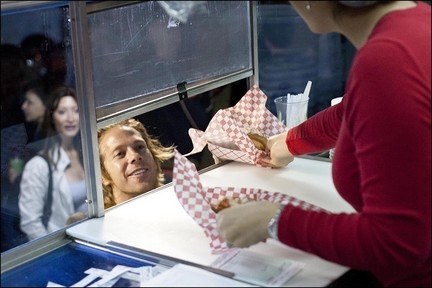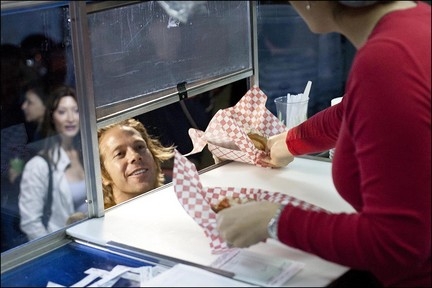
CITY HALL — Tuesday night in front of the California Heritage Museum, a group of food trucks slung tacos and other eclectic fare to a crowd of hungry individuals and families that meandered up and down Main Street.
At that moment, less than a mile away, the Santa Monica City Council was engaged in discussion to determine the fate of the very event, specifically how City Hall plans to regulate what some see as a new and burgeoning industry, and others view as a threat to traditional brick and mortar establishments.
How, exactly, those regulations can be imposed becomes a complicated dance around state and local laws, which mostly hinges on where the truck is parked.
While cities have the ability to impose parking restrictions on roads, those mandates have to apply equally to all vehicles unless there’s a public safety concern.
Otherwise, the state holds ultimate authority over what is or is not allowed on roads, and there is little in the way of specifics about food trucks.
The reason, said Matt Geller, CEO of the SoCal Mobile Food Vendors’ Association, is that the every day driver needs the confidence that when they cross over from Los Angeles into Santa Monica, the rules of the road will be substantially the same.
“It would be confusing for citizens of California if everywhere they went they had a different regulatory framework,” Geller said.
On private property, conversely, City Hall has a great deal more sway, which is why — since August 2010 — the California Heritage Museum has held a temporary permit from City Hall to allow food trucks to operate on its lot.
The museum charges $100 per month to allow the trucks to stay there on Tuesdays, and in turn patrons flock to Main Street to get an inexpensive taste of Southern California street culture.
So far, in the eyes of patrons and many council members, the California Heritage Museum experiment has yielded impressive results.
Mayor Pro Tempore Gleam Davis noted that the lot had not only created a Farmers Market-esque feel, it provided inexpensive food options for families looking for a little nightlife and a meal out.
“I’d rather have them at the food trucks than McDonald’s or Taco Bell,” she joked.
According to a staff survey, the reactions to the food truck night by Main Street businesses have been mixed, but mostly negative. Of the 25 businesses included, 40 percent didn’t want the event to continue.
That percentage was even higher amongst restaurants, at 63 percent.
Still, there’s no consensus amongst business owners over whether or not they want the food truck night to continue, according to a letter by Gary Gordon, executive director of the Main Street Business Improvement Association.
Some of the objections have to do with reported decrease of restaurant business on Tuesday nights, and some have to do with the inequity of the “unlevel playing field,” referring to the lower overhead costs of food trucks over regular restaurants, Gordon wrote.
Another major problem for businesses is parking, which they think is taken up by the food truck patrons.
However, the MSBIA Board has not taken a formal position for or against the trucks, Gordon said.
Neither did the City Council, which concentrated its attention on dealing with problems like areas where the presence of food trucks has gummed up the works on sidewalks and streets.
“The experiment at the Heritage Museum has been successful by and large,” said Mayor Richard Bloom. “I remain concerned about some of the uses elsewhere in the city.”
Most complaints that came to the council focused on the Downtown, where trucks park for long periods of time in violation of parking regulations and serve food to people waiting in lines on sidewalks, causing backup.
Bloom said he’d even seen trucks vending out of the back end, directly into the street.
“That’s something we simply should not allow,” Bloom said.
Another safety, and annoyance, consideration was the proclivity of food trucks to gravitate toward bars, especially around 2 a.m. when the establishments close down.
Those still around for last call tend to keep the party rolling, congregating around the trucks for a bite to eat.
That problem could be solved by just switching the no-parking from 3 a.m. to 2 a.m., but in the meantime, controlling the crowd on Main Street takes four officers and a sergeant, according to a police department representative.
The trick with creating new regulations on the food truck industry is to make sure that policies don’t come with unintended consequences.
One complaint by the business community was that trucks parked in front of shops block the stores from view, which decreases foot traffic.
If the council crafted a rule prohibiting that, noted Councilmember Kevin McKeown, it could also apply to delivery trucks or postal carriers.
“As we look at these things, we want to make sure we don’t single them out uniquely as though they’re a problem for just being food trucks,” McKeown said.
Councilmembers directed staff to come back to them with potential regulations, particularly surrounding curfews and permitting processes for off-street sites.
Geller, who has been working food truck issues since he helped found the mobile vendors’ association in 2010, said he would be happy to help discuss policies he’s seen work in other cities with councilmembers or city staff.
He would not, however, reveal his cards to the public.
“They’re trying to come up with solutions, and they shouldn’t be under pressure from people to implement the things I suggest,” Geller said Wednesday.
ashley@www.smdp.com









